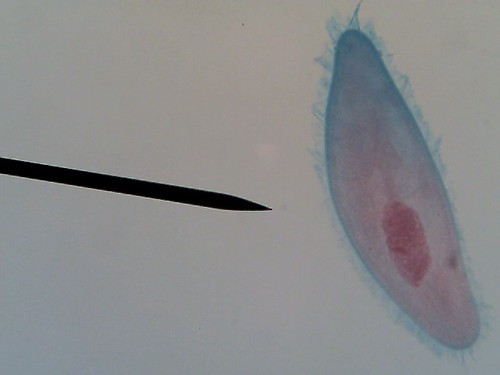In the early 1960s, a fellow named Sonneborn discovered a big peculiarity in a tiny animal, the paramecium. Sonneborn would take a paramecium, and disfigure it. Later, after the paramecium reproduced itself, its children (and their descendants, too!) inherited that same disfiguration. That inheritance raises a question that should disturb and intrigue every living biologist: How was the information — the location and shape of the disfiguration — passed from one generation to the next?
About Paramecia, and About Inheritance
First, a little background about paramecia.A paramecium is a one-celled creature. It has a distinctive shape, rather like that of a slipper; it’s the shape you see repeated on a paisley tie. The paramecium is a ciliate, which is to say that its surface has lots of little, whip-like projections called cilia. The cilia are generally arranged in parallel rows, and within the rows, each cilium has pretty much the same orientation. (This is analogous to the hairs on a patch of your skin — on a small patch the hairs all point in the same direction). The cilia wag back and forth rather like floppy oars. This concerted wagging is how the animal moves itself about.
 Second,
a little background about how shape and other information is passed on
from generation to generation. Every living thing has received from its
parent (or parents) the set of instructions necessary to physically live
and grow. Those instructions are carried, in tickertape fashion, in the
genes. The genes are made entirely of deoxyribonucleic acid (the famous
DNA), arranged as long, long, astoundingly thin, twisty, scrunched-up
tickertape-like molecules. All of modern biology is based on this idea —
that virtually all the physical information that’s passed from parent
to child is contained in the DNA. In a paramecium, the most famous
chunks of DNA are contained in the nucleus. Some other parts of the cell
also contain their own little chunks of DNA.
Second,
a little background about how shape and other information is passed on
from generation to generation. Every living thing has received from its
parent (or parents) the set of instructions necessary to physically live
and grow. Those instructions are carried, in tickertape fashion, in the
genes. The genes are made entirely of deoxyribonucleic acid (the famous
DNA), arranged as long, long, astoundingly thin, twisty, scrunched-up
tickertape-like molecules. All of modern biology is based on this idea —
that virtually all the physical information that’s passed from parent
to child is contained in the DNA. In a paramecium, the most famous
chunks of DNA are contained in the nucleus. Some other parts of the cell
also contain their own little chunks of DNA.What Sonneborn Found
With that background in mind, consider what Sonneborn found, and how puzzling his discovery is.
The startling thing is what happened after the paramecium reproduced. For a paramecium, reproduction is usually a lonely, mitotic affair. The thing just splits itself in two.
Each offspring of a maimed paramecium turned out to have the same graft pattern as its parent, with the rotated patch of cilia in the same, odd orientation. This flipping of the paramecium’s wig makes biologists flip their own wigs, those few who have heard about it.
It’s hard, very hard, to see how this could possibly be inherited via the genes. Yet somehow the information is passed on from the paramecium that got the disfiguration to its children, and on to subsequent generations. How? How?


No comments:
Post a Comment